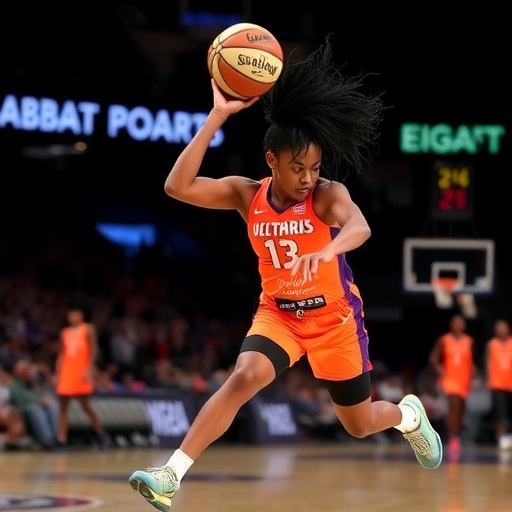Silver’s Bold Prediction Ignites Hope for WNBA Salary Surge
In a game-changing revelation for women’s basketball, NBA Commissioner Adam Silver has forecasted ‘big’ raises for WNBA players as the league gears up for a pivotal new Collective Bargaining Agreement (CBA). Speaking at a recent media event, Silver emphasized that the upcoming negotiations, set against the backdrop of the current CBA’s expiration in 2025, will prioritize substantial salary enhancements to reflect the growing popularity and revenue of the WNBA. This announcement comes at a time when the league is experiencing unprecedented viewership and sponsorship deals, signaling a transformative era for athletes who have long advocated for fair compensation.
- Silver’s Bold Prediction Ignites Hope for WNBA Salary Surge
- Tracing the Evolution of WNBA Salaries Amid Rising Stardom
- Behind-the-Scenes Drama in CBA Talks: Key Players and Stakes
- Expert Insights: How Salary Boosts Could Reshape Women’s Basketball
- Looking Ahead: CBA Outcomes and the Dawn of a New Era in WNBA Prosperity
Silver’s comments, delivered during a press briefing on the broader state of professional basketball, underscore the NBA’s commitment to elevating its sister league. ‘The WNBA has made remarkable strides in recent years, and it’s only fitting that our players see the financial benefits of that success,’ Silver stated. ‘We’re looking at meaningful increases in salary caps and revenue sharing to ensure the women’s game thrives alongside the men’s.’ This optimism is rooted in the WNBA’s record-breaking 2023 season, which saw a 21% rise in attendance and a 170% jump in social media engagement, according to league reports.
For WNBA stars like A’ja Wilson and Breanna Stewart, who have been vocal about pay equity, this news represents a long-overdue victory. The average WNBA salary currently hovers around $120,000 annually, a stark contrast to the NBA’s multimillion-dollar contracts. Silver’s assurance of ‘big’ raises could bridge this gap, potentially doubling or tripling base salaries and introducing more lucrative endorsement opportunities tied to CBA terms.
The timing couldn’t be more critical. With the current CBA, ratified in 2020, set to expire after the 2025 season, negotiations are already underway between the WNBA and the Women’s National Basketball Players Association (WNBPA). Silver’s intervention highlights the intertwined fates of the NBA and WNBA, as the former provides operational and financial support to the latter. This symbiotic relationship has fueled speculation that NBA revenues, projected to exceed $10 billion by 2025, will trickle down more generously to women’s basketball initiatives.
Tracing the Evolution of WNBA Salaries Amid Rising Stardom
The journey toward equitable pay in the WNBA has been a decade-long battle marked by incremental wins and persistent challenges. Launched in 1997 as a counterpart to the NBA, the women’s league started with modest salaries averaging just $30,000 per player. Over the years, advocacy from players and allies has pushed for reforms, culminating in the 2020 CBA that introduced a 53% revenue share model—up from 20%—and established a salary floor and cap adjustments.
Despite these advancements, disparities remain glaring. Top WNBA earners like Diana Taurasi pull in around $235,000 base salary, supplemented by endorsements, while NBA counterparts like LeBron James command over $40 million annually. Adam Silver’s recent pledge addresses this imbalance head-on, promising that the next CBA will incorporate dynamic salary structures linked to media rights deals, which have ballooned from $60 million in 2016 to a potential $200 million by 2025.
Statistics paint a compelling picture of the WNBA’s ascent. The 2024 season opener shattered records with over 1.3 million viewers for the Commissioner’s Cup final, surpassing previous highs. Merchandise sales surged 50% year-over-year, and international expansion into markets like Europe and Asia is on the horizon. These metrics, as Silver noted, justify the push for salary hikes: ‘The economic model is evolving rapidly, and players deserve to be at the forefront of that growth.’
Player testimonials add emotional depth to the narrative. WNBPA President Nneka Ogwumike, a nine-time All-Star, has long championed CBA reforms. In a 2023 interview, she remarked, ‘We’ve built this league with our sweat and passion; now it’s time for the business side to match our investment.’ Silver’s announcement validates these efforts, potentially unlocking veteran minimums exceeding $100,000 and rookie scales that reward emerging talents like Caitlin Clark, whose draft buzz has already boosted league hype.
Behind the scenes, financial modeling suggests that a revamped CBA could allocate up to 50% of new media revenue directly to player salaries. This would not only boost individual earnings but also fund enhanced training facilities, travel perks, and health benefits—areas where the WNBA has lagged. As negotiations progress, the focus on salary equity is poised to redefine women’s basketball as a viable, high-earning career path.
Behind-the-Scenes Drama in CBA Talks: Key Players and Stakes
As the WNBA and WNBPA dive deeper into CBA discussions, the stakes have never been higher. Adam Silver’s role as a mediator between the leagues adds a layer of intrigue, with insiders revealing that NBA executives are actively advising on revenue-sharing clauses. The current agreement’s success in stabilizing the league post-COVID has set a high bar, but demands for ‘big’ salary increases introduce tension.
Key figures in the negotiations include WNBPA Executive Director Terri Jackson, who has emphasized holistic improvements beyond just pay. ‘Salary is crucial, but so are maternity leave policies and mental health support,’ Jackson said in a recent statement. Silver echoed this sentiment, highlighting that the new CBA will address ‘the full spectrum of player welfare’ to attract and retain top talent in women’s basketball.
Potential roadblocks loom, however. The WNBA’s operating budget, estimated at $200 million annually, pales against the NBA’s $10 billion juggernaut. Critics argue that without aggressive marketing and broadcast deals—like the rumored Amazon Prime partnership—salary promises could falter. Yet, Silver remains bullish: ‘We’ve seen the WNBA’s value skyrocket; the numbers support transformative changes.’
Comparative analysis with other women’s sports leagues adds context. The NWSL, for instance, recently secured a CBA with average salaries rising to $50,000, inspiring WNBA negotiators. In women’s basketball, the global FIBA market is expanding, with overseas play still supplementing many WNBA incomes. A stronger CBA could reduce this reliance, allowing players to focus domestically and elevate the league’s profile.
Stakeholders beyond players are watching closely. Sponsors like Nike and State Farm, who poured $75 million into WNBA marketing last year, stand to benefit from a more financially secure league. Fan advocacy groups, such as the WNBA Equity Coalition, have rallied online, amassing over 100,000 signatures for pay reform petitions. This groundswell pressures commissioners like Silver to deliver on promises, ensuring the CBA becomes a landmark in gender equity in sports.
Expert Insights: How Salary Boosts Could Reshape Women’s Basketball
Industry experts are abuzz with predictions on how Adam Silver’s anticipated salary raises will ripple through the WNBA ecosystem. Dr. Cheryl Cooky, a sports sociology professor at Purdue University, views it as a ‘watershed moment.’ ‘Historically, women’s sports have been undervalued; this CBA could normalize six-figure salaries as standard, drawing more athletes to the professional ranks,’ she analyzed in a recent op-ed.
Economists project that if salaries double, the WNBA could see a 30% increase in talent pool depth, reducing injury rates from overplaying abroad. Financial analyst Sarah Jane Glynn from the Women’s Sports Foundation notes, ‘With viewership up 25% this season, revenue projections support these hikes without straining the league’s budget.’ This optimism is tempered by calls for transparency in CBA drafts, ensuring raises aren’t offset by increased ticket prices or reduced perks.
From a marketing standpoint, higher salaries could amplify star power. Imagine rookie phenoms like Angel Reese negotiating deals closer to $500,000 early in their careers—a far cry from today’s $76,000 entry-level pay. This influx of funds might spur infrastructure upgrades, such as dedicated practice arenas in every city, fostering longer player tenures and fan loyalty.
Broader implications extend to societal impact. As women’s basketball gains traction—evidenced by the 2024 NCAA championship drawing 18.7 million viewers—the WNBA’s CBA success could inspire reforms in other domains, from Title IX compliance to corporate gender pay gaps. Silver’s vision aligns with this: ‘Empowering WNBA players financially strengthens the entire basketball community.’ Experts like Glynn foresee a domino effect, where elevated salaries boost endorsement values, creating a virtuous cycle of growth.
Challenges persist, including potential labor disputes if negotiations stall. Historical CBA battles, like the 2019 WNBA lockout threat, serve as cautionary tales. Yet, with Silver’s endorsement and data-driven arguments, the path forward appears promising. Analysts recommend including performance incentives tied to attendance and digital metrics, ensuring salaries evolve with the league’s dynamism.
Looking Ahead: CBA Outcomes and the Dawn of a New Era in WNBA Prosperity
As CBA negotiations accelerate toward a 2025 resolution, the WNBA stands on the cusp of unprecedented prosperity. Adam Silver’s assurance of ‘big’ raises isn’t just rhetoric—it’s a blueprint for sustainability. Preliminary talks suggest salary caps could rise from $1.46 million to over $2.5 million per team, directly benefiting rosters and reserves alike.
Future steps include public forums where players like Sue Bird (in an advisory role) will consult on terms. The WNBPA plans town halls in major cities, gathering input to craft a CBA that prioritizes long-term equity. International outreach, including partnerships with EuroLeague Women, could further inflate revenue streams, padding salary pools.
For fans, this means more competitive, star-studded seasons. Enhanced salaries might lure back overseas veterans full-time, intensifying rivalries and viewership. Economically, a thriving WNBA could generate $500 million in ancillary revenue by 2030, per league forecasts, solidifying women’s basketball as a cultural powerhouse.
Silver’s involvement signals the NBA’s deeper investment, potentially including joint marketing campaigns that cross-pollinate fanbases. As negotiations unfold, all eyes will be on milestones like the 2025 All-Star Game, where CBA updates might be teased. Ultimately, this era promises to honor the grit of WNBA pioneers while propelling the league into a financially empowered future, where talent is rewarded commensurate with impact.










